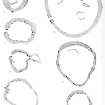RCAHMS Afforestable Land Survey, Glenesslin, Nithsdale
Date February 1991 - March 1992
Event ID 1046116
Category Project
Type Project
Permalink http://canmore.org.uk/event/1046116
The area included within this survey covers about 55 square kilometres disposed on parts of four Ordnance Survey 1: 10,000 map sheets (NX 78 SE/NE and NX 88 NW/SW) and it lies within the parishes of Dunscore and Glencairn. This is the second block of ground in Dumfries and Galloway to be surveyed by the Afforestable Land Survey team, and both areas were suggested by the Regional Archaeologist in response to the threat of afforestation.
A range of monuments typical of the south-west of Scotland was recorded, including small cairns, hut-circles, an unexpectedly large number of burnt mounds, and farmsteads; in addition, the survey identified a hitherto unrecognised group of stone-walled homesteads, possibly dating to the later 1st millennium BC, which may serve to fill a lacuna in the distribution of later prehistoric settlement in western Dumfriesshire. A surprising number of peles, or small towers, were also recorded, forming an element in a wider pattern of medieval and post-medieval settlements which were abandoned as a result of agricultural improvements during the eighteenth and nineteenth centuries.
The solid geology consists of Silurian greywackes (sandstones)which are over lain by irregular deposits of boulder clay and sands and gravels, and the effect of the glacially-derived drift on the landscape is clearly visible in the drumlin-fields along the Shillingland Burn and to the east of Loch Urr. The majority of the Glenesslin area falls within the catchment of the Cairn Water, a tributary of the River Nith, while the remainder drains southwards from Loch Urr, along the River Urr. About half of the ground in Glenesslin is unimproved, but there are patches of improved grassland, together with some arable, in the lower lying ground in the north and east. The Dalmacallan Forest, a relatively recent plantation, blankets an extensive tract, much of it high ground, around the head of the Skelston Burn.
Although various levels of archaeological surveys had already been undertaken in the Glenesslin area, the present survey was the first application of systematic archaeological prospection. On the first edition of the OS 6-inch map (1854-60) a surprising number of small cairns are indicated, but the first specifically antiquarian activity was that of Corrie (1910), and the results of the first general survey were published by the Commission in 1920 (RCAHMS 1920). Little archaeological work was then undertaken until Scott-Elliot's research on small cairns (Scott-Elliot and Roe 1967), which was followed in the1970's and 1980's by Yates' study of all types of cairn (Yates 1984, 1985). The Ordnance Survey map-revision programme of the 1960s and 1970s covered little more than the larger and most obvious monuments which qualified as mappable antiquities, leaving the OS Record Cards limited to a selection of unitary monuments which gave no indication of the quality of the relict landscapes that have been identified as a result of the present survey.
All structures recorded in the field were registered on a proforma in a Husky Hunter portable computer, providing a database from which entries in the National Monuments Record of Scotland (NMRS) were produced. All the sites or finds discussed in the text are accompanied by a unique site reference number; a complete list of the sites surveyed is given in the Gazetteer at the end of the volume.
The survey, which was conducted between February 1991and March 1992, has identified extensive landscapes of multiperiod archaeological remains surviving in largely unimproved ground, and a selection of these are presented as case studies in this volume to illustrate the quantity and range of the remaining archaeological landscapes. Overall, a nested approach has been adopted in illustrating the monuments, producing both maps of large areas (surveyed using Electronic Distance Measuring(EDM) equipment) and detailed surveys (plane-table plans) to illustrate particular points.
The report begins with a summary of the major elements of the land-use and settlement history of the area, providing a chronological context to the following sections, which describe the individual monument types. The narrative is completed by three case studies which describe, in outline, the most significant surviving archaeological landscapes.
RCAHMS 1994
Report: WP 003897
Database: DX 001427
Linework: Non-digital, plotted on 4 x 1:10,000 map sheets







































